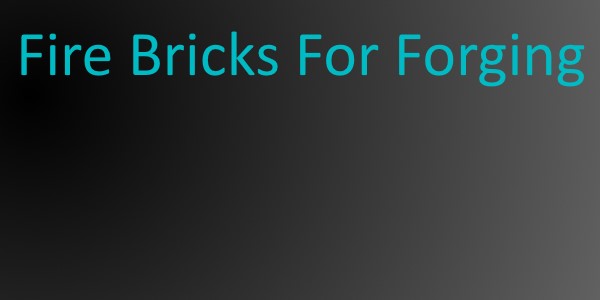
Looking for more information on fire bricks for forge crafting? This comprehensive guide details everything you want to know about fire bricks. This guide includes their uses, material composition, safety dangers, alternatives, and more!
Fire Bricks For Forge and Other Refractory Materials
There are a number of different types of fire bricks you can buy. In the broadest sense, the two most common varieties are called soft fire bricks, and hard fire bricks. When deciding on which firebrick to buy, it’s important to think about how hot your forge will get. The heat of different forges can vary a lot, so try to obtain this heat info if you can.
Once you know your heat requirements, you can compare that with the specifications provided by the brick manufacturer. Remember that all fire bricks can crack with use!
As a general rule of thumb, hard bricks are more durable and will be able to handle higher temperatures. The softer fire bricks tend to heat up quicker than the hard fire bricks. This is because the soft bricks reflect heat, while the hard bricks absorb it. The soft variety are also much easier to cut – just remember to cut in a well ventilated area while wearing a respirator and eye protection. The dust from these bricks is toxic.
If you are looking to buy firebricks for the purpose of a foundry as opposed to a forge, I highly recommend you buy a book called Backyard Foundry by author B. Terry Aspin. This book is short and to the point, but still manages to thoroughly go over all the relevant aspects of casting metal for home machinists and artists.
Uses of FireBricks
Fire bricks are designed for the purpose of withstanding immense temperatures and harsh conditions while maintaining their structure. This makes firebricks ideal for use in furnaces, fireboxes, forges, foundry’s, kilns, fireplaces, and other industrial machines that use heat to morph matter into some new purpose.

Composition of FireBricks and Fire Clays
Fire bricks are known as a refractory object. Refractory is generally seen to be a non-metallic material whose chemical and physical properties make them useful in environments that are above 1000F (500C). Refractory materials may be either man-made or naturally occuring materials.
These refractory materials are usually made from a combination of minerals such as alumina,fireclay,bauxite,chromite,dolomite,magnesite,silicon carbide, zirconia, and others. The exact composition by brick will vary depending on the cost and intended use for the said brick. The intended use is important, as the optimal brick composition will be different in an acidic environment as opposed to a basic environment. Bricks that will be expected to handle industrial usage with intense heat and slag will have to be constructed differently than a run of the mill fireplace brick.
Typical refractories are composed of fireclay, quartz, and silica.
In a basic refractory, the common materials used are calcium oxide, magnesium oxide, dolomite, and chrome-magnesite.
In an acidic environment, the main raw materials used are zirconium dioxide, silicon dioxide, and aluminosilicate. These materials are used in environments where slag and the atmosphere are acidic. They can’t be used under basic conditions.
These bricks are produced using a number of different processes including:dry press process, fused cast, hand molded, formed (normal,fired, or chemically bonded), un-formed(monolithic-plastic, ramming and gunning mass, castables, mortars, dry vibrating cements), and unformed dry refractories.
If you are looking for a more comprehensive and coherent break down of firebrick composition, I highly recommend you check out the following scientific paper:https://www.researchgate.net/publication/287993880_PROPERTY_ANALYSIS_OF_ALUMINA_REFRACTORY_BRICKS_-A_REVIEW. Almost all of the above information on brick composition came from this paper. I’m not affiliated with the above authors in any way, I just think its useful information.
This breakdown on fire brick composition is intended purely to satisfy curiosity. If you are a hobbyist looking to build a forge, it’s much easier to just buy the bricks you need. If you are a student or engineer looking for industrial strength brick creation, I recommend you follow more scientific sources than this one. Some of the materials listed above are caustic or have strong reaction potential, and I recommend extreme caution to all who read this.
Other Refractory Materials
Firebricks for forge are great because they are cheap and rather sturdy. However they are not the best option for all forge designs. The bricks can be hard to shape, and this makes them somewhat more difficult to work with in intricate forge designs. Luckily there is a plethora of refractory materials one can work with. Many of these materials may even be used in conjunction with fire bricks.
In addition to bricks, there is another broad class of refractory materials known as insulation blankets. These come in a number of different makes and models. Most models that I have seen have a continuous use limit between 1800F-2500F. In the metric system that would be between 982C-1371C. These blankets are rather sturdy, and may be used in creative ways to augment a forge. They do tend to get a little crusty with use, especially at temperatures near the upper limit of heat tolerance.
As with most materials designed to withstand high-temperatures, these blankets are toxic to humans. When working with it, make sure to work in a well ventilated area with all the proper safety equipment being used. Due to its toxicity, it is also necessary to coat it with some sort of ceramic paste when using it in a forge.This may help lessen the number of loose fibers that escape the blanket when it’s in use. You do not want to be breathing in the small fibers from the blanket every time you fire up your forge. This paste may also help improve the refractory properties of the forge.
I would also watch the forge temperature. If you are using these blankets for a forge, make sure you get a pyrometer, and make sure you keep temperatures under what the blanket is rated for. Please take safety seriously with these materials, you do not want silicosis or mesothelioma in 20 years.
As alluded to earlier, another class of refractory products exist in the cement/mortar product space. These refractory pastes may be used to enhance a variety of forge designs. For example,I have seen some forge designs on youtube that are based around insulation blankets; To avoid the toxic microparticles, one youtuber coated his insulation blanket in a refractory mortar cement known as satanite. Satanite itself is actually just one product in the broader class of refractory mortars/cements. So make sure to check out other options if you are looking to go this route.
All in all, fire bricks are incredibly useful materials that are used in many production processes. If you are a backyard craftsman looking to build a forge, fire bricks may be a useful part of your forge designs. Just remember that you are playing with extreme forces, and use the utmost caution in all of your crafting endeavours!